Tag: children’s books
Christel Rönns: Det vidunderliga ägget [A most extraordinary egg]
24 January 2013 | Mini reviews, Reviews
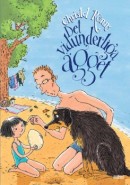 Det vidunderliga ägget
Det vidunderliga ägget
[A most extraordinary egg]
Kuvitus [Ill. by]: Christel Rönns
Helsingfors: Söderströms / Stockholm: Bonnier Carlsen Bokförlag, 2012. 32 p., ill.
ISBN 978-91-638-6857-3
€16.90, hardback
Finnish edition:
Perin erikoinen muna
Suom. [Translated by] Mirjam Ilvas
Helsinki: Tammi, 2012. 30 p., ill.
ISBN 978-951-523-183-3
€15.90, hardback
This is the third work that the graphic designer and illustrator Christel Rönns (born 1960) has written in her own right. With her relaxed and humorous illustration style, Rönns has provided the visual component of some 60 children’s books. This story portrays a family – parents, two little girls and a dog (the author has dedicated her book to the memory of her hovawart dog Freja who died at 14). One summer’s day they find a large egg on the beach and bring it home. But the egg, dropped by accident, reveals a little four-legged creature: named Koi-Koi, it turns out to be delightfully friendly and playful. Nobody actually knows what it is – not even a professor of zoology – but it eats and grows to an enormous size, so the house becomes very cramped (and Koi-Koi’s massive farts send the family running…). But then Koi-Koi begins to disappear at night, and one day he doesn’t come back. Missing a lost pet is a new feeling for the girls (their parents must be secretly relieved, as must the dog!). The story is both funny and gently melancholy, the illustrations detailed and humorous. The book was awarded the Finlandia Junior Prize in 2012.
Sari Peltoniemi: Gattonautti ja muita arkisatuja [The cattonaut and other everyday tales]
24 January 2013 | Mini reviews, Reviews
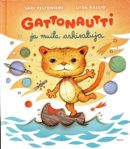 Gattonautti ja muita arkisatuja
Gattonautti ja muita arkisatuja
[The cattonaut and other everyday tales]
Kuvitus [Ill. by]: Liisa Kallio
Helsinki: Tammi, 2012. 67 pp.
ISBN 978-951-31-6576-5
€19.90, hardback
There has been a desperate shortage of short stories and fairy tales for a long time. Now Sari Peltoniemi has bravely risen to this challenge. In her previous young adult novels, she cultivated the ‘new weird’ genre, in which strange and fantastical elements encroach on everyday life. This collection can be categorised as the first Finnish children’s book that makes use of that fantasy subgenre. Peltoniemi’s ten stories also pay homage to traditional Finnish folk tales: a deceased grandfather makes a reappearance to his grandson at midnight; a little sister imagines her teenage sister changing from a fairy into a troll, as in folk tales about changelings. Everyday life is wrenched into strange or absurd situations without warning. Peltoniemi’s portrayals of children display real psychological understanding and insight. The age range for this book, for reading aloud as well as independent reading, extends from preschool to older school-aged children, as the age of the main characters is not emphasised. Liisa Kallio’s child-like, rounded illustration style does indicate, however, that the intended target group is children under 10.
Translated by Ruth Urbom
Sanna Pelliccioni: Onni-poika saa uuden ystävän [Onni gets a new friend]
24 January 2013 | Mini reviews, Reviews
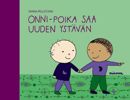 Onni-poika saa uuden ystävän
Onni-poika saa uuden ystävän
[Onni makes a new friend]
Kuvitus [Ill. by]: Sanna Pelliccioni
Helsinki: Minerva, 2012. 32 pp.
ISBN 978-952-492-674-4
€15.90, hardback
The series about a boy named Onni has become a firm favourite among preschool-aged children. Even small children’s picture books are alert to real-life changes in society; in this book – the seventh in the series – Onni gets a new neighbour: a little boy named Aram and Onni quickly become firm friends, even though they do not speak the same language at first. Their friendship across cultural barriers is explained in a straightforward manner that children can grasp. It says something about the introversion of Finnish society and about cultural differences that the friendship is initiated by Aram, who brings some rice pudding made by his mother as a treat for his new neighbours. Pelliccioni’s round-headed figures, characteristic of her style, are suitably simple. She manages to convey fine nuances in their expressions and body language.
Translated by Ruth Urbom
Timo Parvela: Maukka, Väykkä ja Karhu Murhinen [Meowser, Barker and Killington Bear]
24 January 2013 | Mini reviews, Reviews
 Maukka, Väykkä ja Karhu Murhinen
Maukka, Väykkä ja Karhu Murhinen
[Meowser, Barker and Killington Bear]
Kuvitus [Ill. by]: Virpi Talvitie
Helsinki: Tammi, 2012. 127 pp.
ISBN 978-951-31-6167-5
€20.90, hardback
This novel in the Maukka ja Väykkä series tells about friendship among a cat, a dog and a shrew. There is a need for more children’s books for the whole family that can be read aloud. The award-winning duo behind this title have created a book with brief chapters and an engaging setting. Maukka is an attention-seeking cat with a quick temper, while Väykkä is a laid-back, worldly-wise dog. Their life together seems to be a constant squabble over which one of them is right. The latest arrival in the animal community is a little shrew, who has a heart of pure gold despite his fearsome name. He manages to teach the cat-and-dog duo a few things about life. The shrew’s life span is much shorter than that of the cat and dog; Murhinen himself has a sanguine attitude to the matter and teaches Maukka, Väykkä and the reader a number of important things about life and death.
Translated by Ruth Urbom
Moomins, and the meanings of our lives
21 December 2012 | This 'n' that
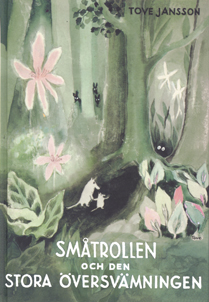
The first ever Moomin story, 1945
Tove Jansson’s Moomin books are widely cherished by children and adults alike. They are funny and charming yet haunting and profound. Lovable Moomintroll; practical and sensible Moominmama; spiky Little My; the terrifying yet complex monster, Groke – Jansson’s creations linger in the mind.
The first ever Moomin book – The Moomins and the Great Flood (Småtrollen och den stora översvämningen, 1945) – was published in the UK in October by Sort Of Books, but Jansson’s writing for adults is also achieving recognition in the English-speaking world.
A Winter Book, a selection of 20 stories by Jansson (Sort Of Books, 2006) was the trigger for a recent event on London’s South Bank. Along with journalist Suzi Feay and writer Philip Ardagh, I was invited to talk about Jansson’s work in general and about these stories in particular.
As Ali Smith notes in her fine introduction to the collection, the texts are ‘beautifully crafted and deceptively simple-seeming’. They are, as she puts it ‘like pieces of scattered light’. She also refers to the stories’ ‘suppleness’ and ‘childlike wilfulness’.
‘The Dark’, for example, offers an apparently random set of snapshots of childhood. Arresting images abound – swaying lamps over an ice rink, swirls in the pattern of a carpet that turn into terrible snakes – to create a tapestry of childhood. It’s like a dream: of ice and fire, fear and safety, a mixture that recalls the secure yet scary world of Moomin valley.
‘Snow’, too, conjures childhood fear. The house that features in this story is unhomely or uncanny, to refer to Freud, and seems haunted by the ghosts of other families. The story ends with the shared resolution between mother and child to return to a place of safety: ‘So we went home.’

Tove Jansson (1914–2001)
The combination of scariness and safety, of comfort and unease, is one of the things that makes Jansson (1914–2001) such a powerful writer, not only for children – although questions of security and fear might have especial resonance in early life – but also for adults, who continue to be haunted by the unknown, but also tempted by it.
The South Bank event also gave participants and audience the chance to talk about other works by Jansson. The Summer Book (Sommarboken, 1972) notably, is a delicate and deft evocation of a summer spent on an island.
The narrative charts the relationship between a grandmother and granddaughter, and at the same time probes such profoundly human questions as love and loss, hope and change and continuity. As always in Jansson, the descriptions are sharp and crisp, and the writing is at once spare and suggestive.
Novels like Fair Play (Rent spel, 1989) and The True Deceiver (Den ärliga bedragaren, 1982) reveal Jansson’s subversive, sly, and subtle sides, which sit alongside her playfulness, warmth, and humour to create a unique aesthetic. Fair Play is a book about the relationship between two women; it’s tender, funny and thoughtful. Never sentimental, it is nonetheless moving. And it’s quietly subversive in its matter-of-fact depiction of a same-sex relationship.
The True Deceiver is set in a snowbound hamlet. A young woman fakes a break-in at the house of an elderly artist, a children’s book illustrator, and a strange dynamic develops between the two women. It’s a book about being outside, about not belonging. The relationship between the women, which is never fully resolved or explained, is especially fascinating.
Jansson excels at showing the human need for both company and privacy, intimacy and autonomy. And her work is profoundly philosophical. In very light, nimble narratives, Jansson explores the meanings of our lives.
Finlandia Junior Prize 2012
5 December 2012 | In the news
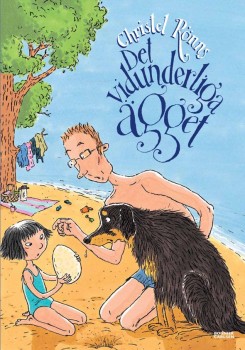 The Finlandia Junior Prize 2012 went to the illustrator and writer Christel Rönns for her book Det vidunderliga ägget (‘The extraordinary egg’, Söderströms & BonnierCarlsen).
The Finlandia Junior Prize 2012 went to the illustrator and writer Christel Rönns for her book Det vidunderliga ägget (‘The extraordinary egg’, Söderströms & BonnierCarlsen).
The winner was chosen from the shortlist of six by the film director and actor Mari Rantasila. Awarding the prize, worth €30,000, on 29 November she said:
‘The book has masterly, original and clear illustrations that support the story; the drawings include amusing details. It is refreshing to read a story about a family that all pulls in the same direction.
‘Det vidunderliga ägget deals with important matters, in a way that is suitable for small children: toleration of difference and the difficulty of loss, underlining that difference is not frightening or negative.’
The following five books also made it to the shortlist: Nörtti: new game (‘The nerd: new game’, Otava), about a schoolboy, bullying and social media by Aleksi Delikouras, Tatu ja Patu pihalla (‘Tatu and Patu on the yard’, Otava), a new picture book in the series about two curious little boys by Aino Havukainen and Sami Toivonen, Hurraa Helsinki! (‘Hurrah Helsinki!’, Tammi), a picture book about Helsinki by Karo Hämäläinen and Salla Savolainen, Puhelias Elias (‘Talkative Elias’, Tammi), an illustrated story about a little boy and his parent’s separation by Essi Kummu and Marika Maijala, and Kirkkaalla liekillä (‘With a bright flame’, Robustos), about 15-year-old Maaria, who lives through difficult times, by Venla Saalo.
How cool is Stinky?
30 November 2012 | This 'n' that
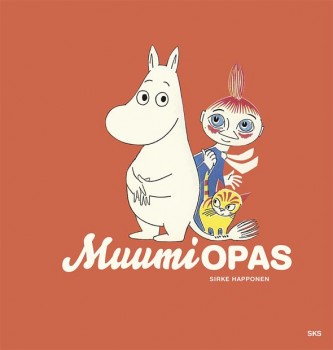
Moomintroll and Mymble: positive role models
‘What reigns in Moomin Valley is a rock-hard hierarchy of those who are cool (Snufkin, Moominmamma, Little My), those who need to be those who are cool (Moomintroll, the Snork Maiden, Sniff, one or two Whompers and Toffles), and those who are absurd (the Hemulen, the Fillyjonk, the Muskrat)’, noted Pia Ingström in her review (Books from Finland 2/2008) of Sirke Happonen’s dissertation on Tove Jansson’s characters.
Snufkin? Fillyjonk? The Moomin world, created by the versatile Finland-Swedish writer and artist Tove Jansson (1914–2001), is peopled with funny-shaped Moomins and a great variety of other creatures who may look a bit odd at first but who are very… human. Jansson’s books have been translated into more than 40 languages. More…
Smart Moomins
27 June 2012 | This 'n' that

From page to screen: Tove Jansson's classic
‘Here’s little Moomintroll, none other,
Hurrying home with milk for Mother,’
are the opening lines of Tove Jansson’s classic 1952 illustrated children’s tale of a sister lost and found, The Book about Moomintroll, Mymble and Little My, in the English poet and novelist Sophie Hannah’s beguiling translation. (Swedish original: Hur gick det sen? Boken om Mymlan, Mumintrollet och Lilla My; illustration: the Finnish version.)
The book has now been released as a smartphone app by the London publisher Sort Of Books and Helsinki’s WSOY in collaboration with the Finnish developer Spinfy.
At the tap of a finger, birds fly, forest creatures crawl up and down tree-trunks, flowers open and close, fish jump and hattifatteners wiggle. Unlike in the Japanese animated cartoons that have done so much to make the Moomins well-known worldwide, this is achieved without doing any violence to Jansson’s original graphics.
The app can be played either in text or, for very small children, read-to mode, voiced by the actor Sam West. Three more Moomin apps are scheduled for release later this year.
Maria Vuorio: Kuningattaren viitta ja muita kiperiä kysymyksiä [The Queen’s cloak and other knotty issues]
19 January 2012 | Mini reviews, Reviews
 Kuningattaren viitta ja muita kiperiä kysymyksiä
Kuningattaren viitta ja muita kiperiä kysymyksiä
[The Queen’s cloak and other knotty issues]
Kuvitus [Ill. by]: Virpi Talvitie
Helsinki: Tammi, 2011. 71 p.
ISBN 978-951-31-6252-8
€ 20.60, hardback
The style of Maria Vuorio’s books demands quiet concentration – but you could get quite hooked on their slow, thoughtful, gentle story-telling. Vuorio carries on the tradition of classic animal fables, following in the footsteps of Hans Christian Andersen, but with a personal twist. She is masterful in describing different emotional states – whether evoking the inner lives of humans or of anthropomorphised animals. Her stories and fairy tales hand the reader a magnifying glass that brings into view even the smallest, most insignificant creature or thing. The entire universe is present in the stories, for example when an earthworm ponders the meaning of life, a bear breaks into the National Museum, or a noxious insect imperils cultural exchange between Finland and Denmark. Talvitie has drawn an allegorical picture for each tale.
Translated by Fleur Jeremiah and Emily Jeremiah
Jani Kaaro: Evoluutio [Evolution]
18 January 2012 | Mini reviews, Reviews
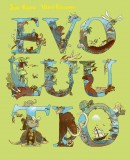 Evoluutio
Evoluutio
[Evoluutio]
Kuvitus [Ill. by]: Väinö Heinonen
Helsinki: BTJ Finland Oy/ Avain, 2011. 64 p., ill.
ISBN 978-951-692-766-7
€ 19.90, hardback
This non-fiction book, intended for 8- to 14-year-olds, takes as its main character Charles Darwin, who as a child begins to ponder where people came from. Various myths about the origins of the world, achievements of European natural historians and problems of early evolutionary theorists are explored briefly but elucidatingly; they are linked to the acquisition of new knowledge as the church fathers continue to trust in the Bible. The prehistory of the Earth, evolution and natural selection, animal populations, man and his ancestors are explained with the aid of plentiful and humorous illustrations. Scientific results are interestingly presented, but a separate fact box, for example, on the structure of the cell or the nature of DNA might have been useful. In the last picture, the 200,000-year-old Homo sapiens is seen scrawling his cave paintings: ‘so long as we are genetically unique individuals, our evolution will never cease’.
Translated by Hildi Hawkins
Hannele Huovi & Kristiina Louhi: Jättityttö ja Pirhonen [The giant girl and Mr Pirhonen]
17 January 2012 | Mini reviews, Reviews
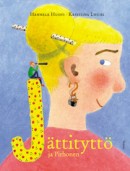 Jättityttö ja Pirhonen
Jättityttö ja Pirhonen
[The giant girl and Mr Pirhonen]
Kuvitus [Ill. by]: Kristiina Louhi
Helsinki: Tammi, 2011. 31 p.
ISBN 978-951-31-5852-1
€ 19.95, hardback
Hannele Huovi and Kristiina Louhi, two eminent professionals in the field of children’s literature, have been collaborating for a long time. Their mutual trust is reflected in the way they grant each other artistic freedom, at times submitting to the text, at others to the illustrations. The depiction of the love story between a giant girl and a tiny man was an exceptional challenge for the illustrator; Tyyne’s tears nearly drown her tiny friend, and to see him properly, she needs a magnifying glass! Louhi has again kept her style economical, and she boldly paints large expanses of colour and forms. Alongside the unequal but happy love story, this picture book deals with tolerance. Tyyne’s enormous size effectively manifests her feeling that she is an outsider. The book also advocates a relaxed attitude to life and the avoidance of unnecessary strain. The example of the giant girl helps the reader to develop a sense of proportion and to realise the value of the everyday.
Translated by Fleur Jeremiah and Emily Jeremiah
Leena Krohn: Auringon lapsia [Children of the sun]
16 January 2012 | Mini reviews, Reviews
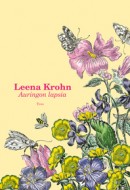 Auringon lapsia
Auringon lapsia
[Children of the sun]
Kuvitus [Ill. by]: Inari Krohn
Helsinki: Teos, 2011. 32 p.
ISBN 978-951-851-311-0
€ 29.40, hardback
It is great news that Leena Krohn has not abandoned the young readership she first addressed through her first book Vihreä vallankumous (‘The green revolution’, 1970), an ecocritical title that also touched on active citizenship. This novel, too, is about the encounter between man and nature. Ten-year-old Orvokki (Violet) is a delivery girl for a florist; like her, the reader is incited to marvel with naive curiosity at life’s various wonders. Krohn is supremely good at writing literature that knows no age limits. Nothing here will go over a child’s head; the essence of the book is accessible to all. In this nicely old-fashioned children’s novel the measured language and expression are pleasing both to the eye and the ear. The hand-coloured graphic prints by the artist (and writer’s sister) Inari Krohn are a homage to Maria Sibylla Merian (1647–1717), the German natural scientist and illustrator who produced life-like paintings of insects and plants.
Translated by Fleur Jeremiah and Emily Jeremiah
Tuuve Aro: Korson purppuraruusu [The purple rose of Korso]
16 January 2012 | Mini reviews, Reviews
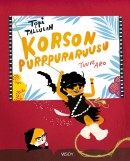 Korson purppuraruusu
Korson purppuraruusu
[The purple rose of Korso]
Kuvitus [Ill. by]: Sanna Mander
Helsinki: WSOY, 2011. 109 p.
ISBN 978-951-0-38052-9
€ 25.70, hardback
Sometimes a book’s appearance is enough to win the reader over. The first children’s novel by writer and film critic Tuuve Aro (born 1973) encourages the belief that things will work out for the best. The book’s positive undertones are also reflected in Mander’s fresh illustrations, which exude retro-nostalgia for the 1950s and 1960s in shades of orange, black, and brown. Tallulah, a jungle princess, turns up unexpectedly to sort out the complicated affairs of Topi, a schoolboy who is being bullied. Tallulah comes into the suburb of Korso from the silver screen, out of Woody Allen’s film The Purple Rose of Cairo. The jungle princess helps Topi to see the bleak suburb as an exotic habitat where adventures are waiting just round the corner. The adult reader gets to enjoy a few carefully chosen references to major cinematic landmarks. Aro eschews problem-centred realism and angst, even though the children’s problems are an indirect result of decisions taken by adults. The Tallulah figure incorporates a hefty dose of anarchy, familiar from Astrid Lindgren’s Pippi Longstocking.
Translated by Fleur Jeremiah and Emily Jeremiah
Once upon a time…
13 January 2012 | Articles, Non-fiction
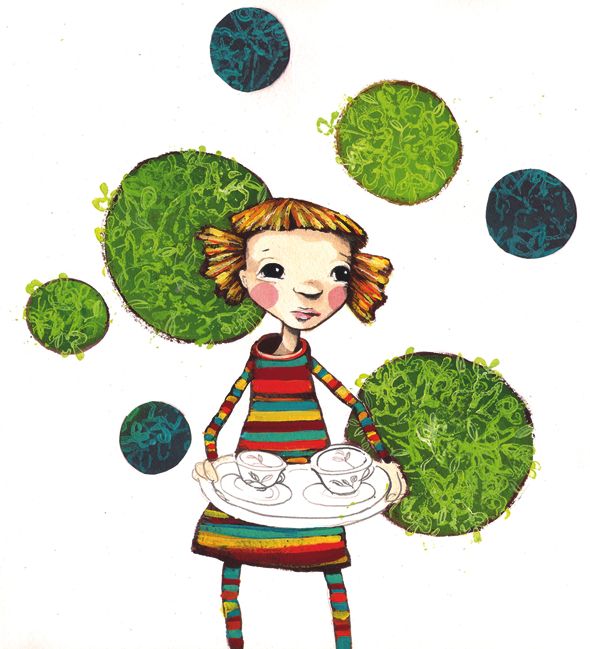
Sari Airola's illustration in Silva och teservisen som fick fötter (‘Silva and the tea set that took to its feet’, Schildts) by Sanna Tahvanainen
The future of book publishing is not easy to predict. Books for children and young people are still produced in large quantities, and there’s no shortage of quality, either. But will the books find their readers? Päivi Heikkilä-Halttunen takes a look at the trends of 2011, while in the review section we’ve picked out a selection of last year’s best titles
The supply of titles for children and young adults is greater than ever, but the attention the Finnish print media pays to them continues to diminish. Writing about this genre appears increasingly ghettoised, featuring only in specialist publications or internet chat rooms and blogs.
Yet, defying the prospect of a recession, Suomen lastenkirjakauppa, a bookshop specialising in children’s literature, was re-established in central Helsinki in autumn 2011, following a ten-year break. Pro lastenkirjallisuus – Pro barnlitteraturen ry, the Finnish society for the promotion of children’s literature, has been making efforts to found a Helsinki centre dedicated to writing and illustration for children. The society made progress in this ambition when it organised a pilot event in May 2011. More…
Sanna Tahvanainen & Sari Airola: Silva och teservicen som fick fötter [Silva and the tea set that took to its feet]
13 January 2012 | Mini reviews, Reviews
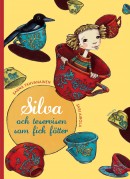 Silva och teservicen som fick fötter
Silva och teservicen som fick fötter
[Silva and the tea set that took to its feet]
Kuvitus [Ill. by]: Sari Airola
Helsingfors: Schildts, 2011. 32 p.
ISBN 78-951-50-2053-6
€ 21.20, hardback
Silva ja teeastiasto joka sai jalat alleen
Suomennos [Translation from Swedish into Finnish]: Jyrki Kiiskinen
Helsinki: Schildts, 2011. 32 p.
ISBN 978-951-50-2054-3
€ 21.20, hardback
Sari Airola’s ability to depict different emotions makes her one of the most interesting Finnish illustrators of children’s books. Airola has long lived in Hong Kong and one can often sense an oriental spirit in her work. In this book, she makes use of Asian textile printing plates to enliven the surfaces of the images. The subject of this debut children’s book by Tahvanainen (born 1975), who is also a poet and novelist, evokes empathy with family situations that deviate from the norm. Silva lives in a big house with her mother, an isolated control freak and migraine sufferer. When her mother suffers an episode, Silva is unable to establish any contact with her and feels insecure. Although the text is allegorical, the book’s message, which concerns a parent’s caring responsibilities and a child’s need to be loved, remains accessible to children. Once the migraine attack is over, the mother goes out to look for Silva; mother and daughter are reconciled when Silva, at last, puts her fears into words.
Translated by Fleur Jeremiah and Emily Jeremiah
